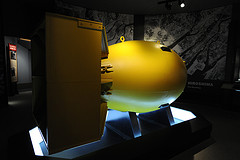Nuclear bombs work on account of the energy generated from radiated particles. The reaction is extremely fast and therefore causes massive destruction. The two nuclear reactions fission and fusion can cause a nuclear explosion. Fission breaks nucleus apart and fusion makes them fall into one another. Plutonium and uranium are effective for fission bombs because they are radioactive and splitting them generates the required energy, while lighter elements like hydrogen are useful for fusion bombs (i.e. The hydrogen bomb in World War 2). Fusion bombs are somewhat less efficient.
A nuclear bomb must have a shell to hold it – this will increase its effectiveness. It needs a trigger mechanism and the nuclear components (e.g. Plutonium, uranium or hydrogen). A supercritical mass must be reached which will cause a chain reaction, resulting in an explosion. The components must be kept in subcritical mass before detonation to prevent the process from occurring too early. A gun trigger is a successful way of merging the two subcritical masses: An explosion fires one mass into the other and the process begins. In modern bombs, compression of the core by TNT explosions is key to reaching supercritical mass. In nuclear fission, the unstable atoms constantly break up, releasing energy. This is what we call radiation. In a fission bomb, the compression from the TNT explosions cause the radiation atoms to collide – causing a chain reaction. It is all this energy that causes such a massive explosion.
In fusion (or thermonuclear) bombs, the atoms inside (deuterium and tritium) are forced together by atomic explosions to create a new nucleus (nuclear fusion) which expels the extra energy as radiation. The energy expelled is massive. On top of this, vast amounts of deadly radiation are released. This is referred to as fallout. The destructive power of nuclear bombs can devastate larger areas than any other weapon known to man.
A nuclear bomb must have a shell to hold it – this will increase its effectiveness. It needs a trigger mechanism and the nuclear components (e.g. Plutonium, uranium or hydrogen). A supercritical mass must be reached which will cause a chain reaction, resulting in an explosion. The components must be kept in subcritical mass before detonation to prevent the process from occurring too early. A gun trigger is a successful way of merging the two subcritical masses: An explosion fires one mass into the other and the process begins. In modern bombs, compression of the core by TNT explosions is key to reaching supercritical mass. In nuclear fission, the unstable atoms constantly break up, releasing energy. This is what we call radiation. In a fission bomb, the compression from the TNT explosions cause the radiation atoms to collide – causing a chain reaction. It is all this energy that causes such a massive explosion.
In fusion (or thermonuclear) bombs, the atoms inside (deuterium and tritium) are forced together by atomic explosions to create a new nucleus (nuclear fusion) which expels the extra energy as radiation. The energy expelled is massive. On top of this, vast amounts of deadly radiation are released. This is referred to as fallout. The destructive power of nuclear bombs can devastate larger areas than any other weapon known to man.

